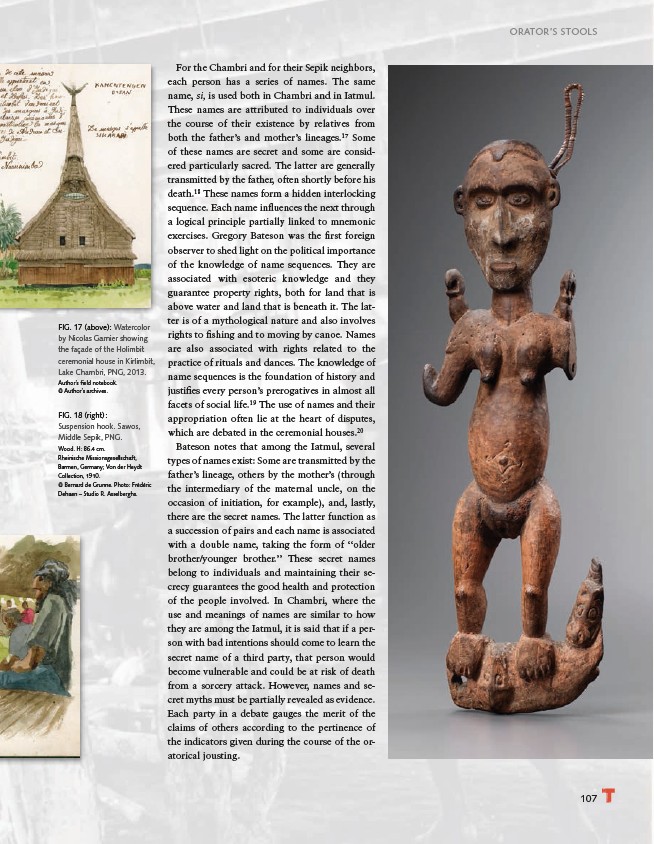
107
FIG. 17 (above): Watercolor
by Nicolas Garnier showing
the façade of the Holimbit
ceremonial house in Kirlimbit,
Lake Chambri, PNG, 2013.
Author’s fi eld notebook.
© Author’s archives.
FIG. 18 (right):
Suspension hook. Sawos,
Middle Sepik, PNG.
Wood. H: 86.4 cm.
Rheinische Missionsgesellschaft,
Barmen, Germany; Von der Heydt
Collection, 1910.
© Bernard de Grunne. Photo: Frédéric
Dehaen – Studio R. Asselberghs.
For the Chambri and for their Sepik neighbors,
each person has a series of names. The same
name, si, is used both in Chambri and in Iatmul.
These names are attributed to individuals over
the course of their existence by relatives from
both the father’s and mother’s lineages.17 Some
of these names are secret and some are considered
particularly sacred. The latter are generally
transmitted by the father, often shortly before his
death.18 These names form a hidden interlocking
sequence. Each name infl uences the next through
a logical principle partially linked to mnemonic
exercises. Gregory Bateson was the fi rst foreign
observer to shed light on the political importance
of the knowledge of name sequences. They are
associated with esoteric knowledge and they
guarantee property rights, both for land that is
above water and land that is beneath it. The latter
is of a mythological nature and also involves
rights to fi shing and to moving by canoe. Names
are also associated with rights related to the
practice of rituals and dances. The knowledge of
name sequences is the foundation of history and
justifi es every person’s prerogatives in almost all
facets of social life.19 The use of names and their
appropriation often lie at the heart of disputes,
which are debated in the ceremonial houses.20
Bateson notes that among the Iatmul, several
types of names exist: Some are transmitted by the
father’s lineage, others by the mother’s (through
the intermediary of the maternal uncle, on the
occasion of initiation, for example), and, lastly,
there are the secret names. The latter function as
a succession of pairs and each name is associated
with a double name, taking the form of “older
brother/younger brother.” These secret names
belong to individuals and maintaining their secrecy
guarantees the good health and protection
of the people involved. In Chambri, where the
use and meanings of names are similar to how
they are among the Iatmul, it is said that if a person
with bad intentions should come to learn the
secret name of a third party, that person would
become vulnerable and could be at risk of death
from a sorcery attack. However, names and secret
myths must be partially revealed as evidence.
Each party in a debate gauges the merit of the
claims of others according to the pertinence of
the indicators given during the course of the oratorical
jousting.
ORATOR’S STOOLS